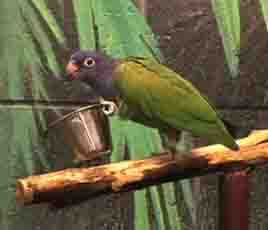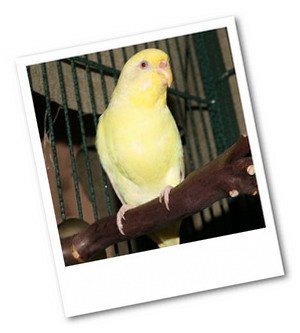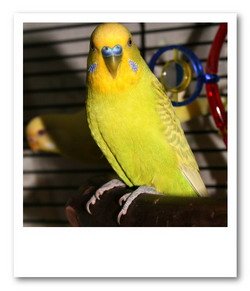Once you recognize parakeet illness symptoms you will need to do something about it. The best thing you can do to help a sick pet is to take it to the vet. Until you do, learn some first aid for sick parakeet.
Note that when visiting a Vet, it is helpful to bring the bird in his actual cage. Birds will attempt to hide illness when in a strange environment as a protective measure. Bringing the parakeet cage will make the bird comfortable and provide the Vet an opportunity to check things such as hygiene and even diet. For example, all because you are feeding your Parakeet a high quality food does not mean that he is eating it.
A veterinarian will observe the bird's activity level, posture, attitude and appearance as compared to other avian patients.
Parakeet Illness Symptoms
- Partially closed eyes
- Feather ruffling
- Blinking the eyes more than normal
- Tucking the head under the wing
- Difficulty breathing: Opened mouth breathing indicates shortness of breath
- Excessive chest movement
- Excessive tail movement when breathing
- Sitting on the bottom of the cage
- Hunched when standing
- Straining when defecating
- Balance problems
- Shivering
- Rapid movement of feathers
- Poor response to an external stimulus
- Lameness
- Drooped wings (indicates arthritis, fracture, ligament damage, bruising, nerve damage)
- Shifting weight to one side of the body
If you see your pet is all fluffy, separate him from the other birds (if there are any). If you can, measure your parakeet's temperature.
When sick, parakeet's temperature will be lower than when healthy. Healthy birds have temperatures of 40.5 to 42.6 degrees Celsius (105 to 108.5 degrees Fahrenheit). The lower the temperature goes - more severe the illness is.
Other signs of illness include abnormal feather coloring, too many pin feathers (developing feather), and overgrown nails.
It would be good to put the bird in a warmer environment, where the air temperature would be closer to 38 degrees Celsius (100 deg. F).
Put some clean paper towels on the cage bottom and change them several times a day.
It is very important to maintain hygiene on the highest level when it comes to illness prevention and treatment.
Friendly And Easy Bird Species For Kids And Beginners
 The Parakeet Diet needs to contain a collection of vital nutrients. A parakeet on a seed based diet alone may not be receiving all of the nutrients needed, particularly when young.
The Parakeet Diet needs to contain a collection of vital nutrients. A parakeet on a seed based diet alone may not be receiving all of the nutrients needed, particularly when young.
Often, simple factors are resulting in a sick parakeet and parakeet health problems:
- Environment: Use of household disinfectants (Lysol, Ammonia, Clorox), furniture polish, floor wax, paint, hair spray, carpet cleaner, furniture cleaner, dry cleaning fluid, fumes from chemicals, kerosene heaters, cigarette smoke
- Poor Nutrition: overuse of vitamin supplements, an all-seed diet can lead to a slow decline over months and years (only feed quality formulated diets)
- Poor hygiene: dirty cage
- Bird History: birds caught in the wild may have been exposed to disease
- Time at home: birds kept for less than a year may be stressed, more than a year nutrition may be the cause
- New birds added to home: New birds can introduce new illnesses
- Lack of Sunlight or fresh air
- Recent dietary change
- Medications or OTC medicines
- Changes in Parakeet behavior
What Does It Mean When Your Parakeets Feathers Are Changing?
There are two periods in a year when parakeets are more sensitive. It happens when they are changing feathers. Normally that would be March and September (European climate).
This period lasts about 4 to 7 weeks. Changing feathers exhausts the bird and it is much easier for him to catch some parakeet illness.
While changing feathers the bird can get really nervous. He will sometimes nap a lot while changing feathers and he will be all fluffy with a lot of feathers falling off. As we know, these are parakeet illness symptoms but in this case there is probably nothing wrong with the bird.
At times the bird will pluck old feathers. Sometimes that can cause injuries and bleeding. You can stop the bleeding by applying light pressure to the spot with a piece of cotton.
Birds kept indoors, like the pets I am talking about, have more trouble in this period than the birds in breeding houses.
When the temperature suddenly raises (like in the fall when the heating in apartments starts), they can suddenly loose a lot of feathers. They will look pretty bold.

One more situation that will make this more difficult on the bird will be if the apartment air has less than 40% humidity.
Anyway, you should pay special attention to your bird in this period. If it is possible you should keep the area where the bird is located warm, as the bird will be ?naked? and more sensitive to cold.
In this period you should feed budgie parakeets better. So, besides seeds, fruit and vegetables, you should give them hard boiled egg whites and some vitamins.
Once more, we are reminding you that all these advices are just first aid for the illness. If you see your pet is sick, try to get him to the vet as soon as you can.
And let us not underestimate the power of preventing illnesses. Feed your pet the best food, keep him clean, make sure he gets enough fresh air, give him toys so he can enjoy himself and be his friend. That will do more for his health than any medicine in the world.

Have a Pet Question for our Vet? We'll Answer it for Free!
Would you like to ask our Veterinarian a question? Just ask and we'll get back at you with an answer from our Vet for free!
If you need an immediate response, we suggest trying this online veterinary service that is available now to answer your questions.
Other questions answered
Click below to see questions from other visitors to this page...
Parakeet has Ruffled Area Above the Beak Not rated yet
Reader Question: Ruffled Feathers Above Parakeet Beek
I noticed on Monday one of my parakeets had area ruffled above beak, now another one has the …
What Could Cause a Bird Beak to Turn to a Blue Gray Color? Not rated yet
Reader Question on Meaning of a Bird Beak Turning a Blue Gray Color
Does it mean anything if your birds beak turns a blue gray color?
Suggestion …
Pet Parakeet Budgy has a Swollen Abdomen and Feathers Will Not Grow Back Not rated yet
My Pet parakeet Budgy has a swollen abdomen and feathers won’t grow back but behaves okay and eats ok. Just has a weird bald patch on the butt.
Not …